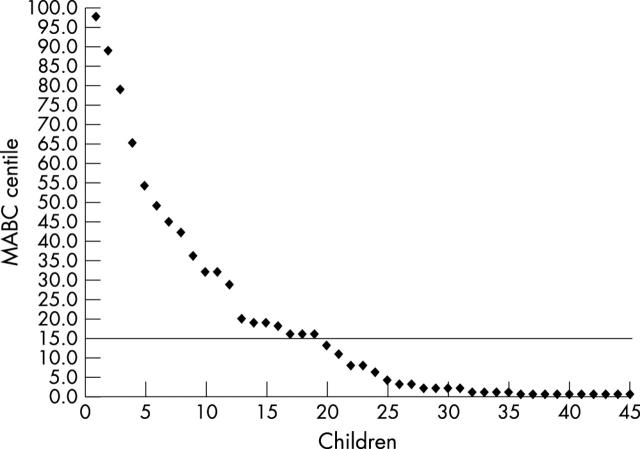Abstract
Aims: To assess children referred to the Occupational Therapy Service in Gwent with a presumptive diagnosis of developmental coordination disorder (DCD) in order to investigate the appropriateness of their referral.
Methods: Non-urgent referrals to the occupational therapy team for children with coordination difficulties in Gwent between June 2001 and February 2002 were studied.
Results: Eighty nine children, aged 5–10 years, were identified. Thirteen children who would not meet the DCD criteria were excluded. This left 76 children, 67 of whom were actually assessed. If the 15th centile for the Movement ABC is used, 26 children met and 41 failed one of the four criteria in DSM IV (38%). If the 5th centile is used, 21 children met and 46 failed one of the four criteria in the DSM (31%). Of the major groups of referrers, school nurses did the best with 48% success rate; better than the paediatricians with 32%. The worst success rate was in educational psychologists and teachers, with only 20% of cases referred actually having DCD. These differences did not quite reach statistical significance.
Conclusions: Less than a third of referrals to occupational therapy for DCD actually have the diagnosis. This suggests that referrers need further training and guidance. This includes a knowledge and understanding of the DSM IV criteria and their interpretation. This would reduce the number of time consuming, unnecessary assessments being done. A triage procedure with a checklist would be a good way forward and we hope to devise one to assist referrers with this process.
Full Text
The Full Text of this article is available as a PDF (161.8 KB).
Figure 1 .
MABC centiles for cases and non-cases due to >15th centile on MABC.
Selected References
These references are in PubMed. This may not be the complete list of references from this article.
- Gueze R. H., Jongmans M. J., Schoemaker M. M., Smits-Engelsman B. C. Clinical and research diagnostic criteria for developmental coordination disorder: a review and discussion. Hum Mov Sci. 2001 Mar;20(1-2):7–47. doi: 10.1016/s0167-9457(01)00027-6. [DOI] [PubMed] [Google Scholar]
- Hellgren L., Gillberg C., Gillberg I. C., Enerskog I. Children with deficits in attention, motor control and perception (DAMP) almost grown up: general health at 16 years. Dev Med Child Neurol. 1993 Oct;35(10):881–892. doi: 10.1111/j.1469-8749.1993.tb11565.x. [DOI] [PubMed] [Google Scholar]
- Losse A., Henderson S. E., Elliman D., Hall D., Knight E., Jongmans M. Clumsiness in children--do they grow out of it? A 10-year follow-up study. Dev Med Child Neurol. 1991 Jan;33(1):55–68. doi: 10.1111/j.1469-8749.1991.tb14785.x. [DOI] [PubMed] [Google Scholar]
- Missiuna C., Pollock N. Perceived efficacy and goal setting in young children. Can J Occup Ther. 2000 Apr;67(2):101–109. doi: 10.1177/000841740006700303. [DOI] [PubMed] [Google Scholar]
- Soorani-Lunsing R. J., Hadders-Algra M., Olinga A. A., Huisjes H. J., Touwen B. C. Is minor neurological dysfunction at 12 years related to behaviour and cognition? Dev Med Child Neurol. 1993 Apr;35(4):321–330. doi: 10.1111/j.1469-8749.1993.tb11644.x. [DOI] [PubMed] [Google Scholar]
- Sugden D. A., Chambers M. E. Intervention approaches and children with developmental coordination disorder. Pediatr Rehabil. 1998 Oct-Dec;2(4):139–147. doi: 10.3109/17518429809060945. [DOI] [PubMed] [Google Scholar]



